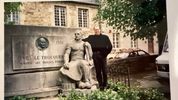
I was recommended “The essentialism - the disciplined pursuit of less” by Mike Garrison in summary it’s a book how to do as little as possible. Not how to be lazy, but to do just what is essential.
We have all been in a two meeting, where we have thought “this could have been an email”. While sitting there we realise that a colleague isn’t there. Next day, they call up and say “so what happened in that meeting I missed?” and you distill that 2 hours into 2 minutes.
That person is an essentialist.
Greg McKeown takes you through a journey, that will allow you to differentiate between the noise and signal of the time in your life. How you can eliminate wasted time and processes you can put in place so you can focus your time so that you start using it wisely. One such example, is the use of routine so that your mind is used for the important things, rather than using brain power on the mundane.

I’ve read a lot of books recently on the “future of work” (all of them will have been reviewed here) and to date they have all been based around “people” what has been traditionally known as “human resources”. What I mean here is that the books have focused on the new processes we need to have in place to lead, manage and nurture people.
Chris has approached this book from a different angle, as he has always worked in commercial real estate. Which means the the narrative in the book is based around the structure of the office and how that impacts on the people. The book was published during the Covid19 pandemic so at the time of writing (April 2021) this is highly topical.
Following the global working from home experiment, (covid-19 pandemic) where do we see our office now? At home? in an office? a hybrid of the two? A third place? I still don’t know we are sure, but Chris is great at adding flesh to the bones of the debate.
The book finishes with Chris sharing his experience of the massive BBC commercial real estate transformation. As a BBC child (my father was a BBC sound engineer based at TV centre in London and then Pebble Mill in Birmingham) I found the insight shared fascinating. Did you know that the architect of TV centre had a brief for the land and to come up with an idea for the building he went to the pub and pencilled in a question mark and he didn’t know what to design. TV centre was then built as a question mark. It really was designed on the back of an envelope. Funny how things turn out.

“Learnings from five Olympic games” is the rower, France Houghton’s notes on teams, training, meetings, technique and injury. Don’t expect a long, in-depth book, it’s 97 pages and took me an hour to read. If you are looking for insight into a successful athletes routine and how she coped with stress and injury, it’s worth a quick read.

My partners mother is Indonesian and she grew up just after the second world war, when Indonesia was fighting with the Dutch colonists for independence. We asked her about that time, what it was like and she suggested that my partner and I read this book.
“Revolt in paradise” is the autobiography of K’tut Tantri (Indonesian name) born Muriel Stuart Walker, who grew up in the Isle of Man and then went onto live in America with her mother. After seeing a film in LA about Indonesia, she traveled, alone, with no knowledge of the country, it’s language, customers, money and this is her story.
She also adopted the Balinese name K'tut Tantri, which translated into English as "fourth-born child." During her time in Indonesia, Tantri also became fluent in the Balinese and Indonesian languages. Later, she established a hotel in Kuta where she developed a fondness for the Indonesians and an aversion towards the Dutch, whom she regarded as "arrogant colonialists."
During the Japanese occupation of Indonesia, Tantri chose to remain behind with the Balinese, who she regarded as her people. She was finally, arrested, tortured and imprisoned by the Japanese. Then with, Indonesia emerging from the war, it, of course wanted its independence and had to enter into a war with the Dutch who had returned to run the country.
She became a radio broadcaster for the Voice of Free Indonesia. Due to her work for the Indonesian government, she became known as "Surabaya Sue" among the British and Dutch forces occupying Java
The story is amazing and in many places I thought “you couldn’t make this up”, because it does seem total fantasy. That said, she seems totally credible and you soon take her into her heart and she always wanted to do the right thing for the Indonesians. And as an Indonesian suggested reading the book, who am I to argue?

I was recommended “why we sleep” by somebody on a podcast I was listening to. I have come close to burn out a number of times in life and sleep and getting enough sleep is very important to me.
This book is not about how to get better sleep, well it is, but it’s not a book about wellness. Matthew Walker is a University professor and teaches people about why we sleep, the chemical balance in the body and the internal factors and the external factors that mean we will get a good night's sleep.
Also, what happens, if we don’t get a good night's sleep.
At 339 pages, it’s a pretty weighty investment, but you do walk away with some great insight and if you're getting a good night's sleep because of that, it was worth the investment.

Annie Duke, the author of “thinking in bets” is a former World Series of Poker champion, turned business consultant. In the book, Annie discusses the importance of the different types of decisions. Good decisions can generate, bad outcomes and bad decisions can generate great outcomes. This is something she has learned from playing poker.
She also discusses the difference between “skill” and “luck”, often in life if we had a good outcome we put that down to skill and a bad outcome, we put down to bad luck. Surely everything is about skill? Annie discusses that if you say to people “will you take a bet on that?” people will start unpacking their belief systems and the knowledge we have which we assume to be true. Once pushed, to put our money where our belief systems are will we really do it?
Finally she discusses the need to have an open mind in life and a lifelong learner.
I certainly enjoyed the book and it’s worth adding to the reading list.

Bill Palmer, like many of us are annoyed by the constant connection requests and then a pitch or the constant pitches on social media. This isn’t social selling, this is cold calling on a social network. Or anti-social selling as Bill calls it.
Bill calls out the bad practice and points out why the people perpetrating it are failing, many instances you cannot help but laugh. Bill uses actual connection requests as example and you do wonder how people can have such a total lack of understanding of why a buyer buys and why they don’t buy.
It’s not a long book, but it’s educational and you have to laugh out loud at many of Bill’s comments and insight.

25 years ago, I was at Coventry (Lanchester) Polytechnic, now called, Coventry University and a chart topping band of the time, The Communards played. At that gig I attended, on keyboards, was a young Richard Coles, like the Poly today, he too has a grander title of The Reverend Richard Coles.
I listen to Richard every Saturday on his BBC radio 4 show, “Saturday live” and thought I would give the book a try. The book talks about the death of his partner David, who died at a very young age and how Richard dealt with it.
Loved the book, Richard writes with a sense of warmth and vulnerability that unfolds through the book. This is not a religious book, Richard explains his feeling both factual and with a sense of humour. It also explains the feels you have on the good days and the bad days.
I know that I will be needing to deal with death very soon as both my parents are “getting on” and I want to make sure I have the skills and “the tools” to deal with it. I’m pleased that it’s “OK” to go to pieces.

I rate the book 5 stars as Dan has given a first class job of detailing how to use LinkedIn, and if you are looking for a basic guide then this is ideal for you.
When I was talking to my publisher about my first book “social selling - techniques to influence buyers and change makers” they said to me “the world does not need another book about LinkedIn”.
The first reason was that, as Linkedin is continually evolving, the book will soon be out of date and the second reason was that there are so many books on how to use LinkedIn.
Against that context, Dan has courageously taken on the challenge of a book about LinkedIn and on page 3 he points out there are 600 million people on Linkedin and at the time of writing this review there are 756 million. While that fact should not distract the reader, you can see a flaw. There is, nothing on “creator mode” for example, so there will be a shelf life to this book at some point.
I’m also aware of four other Linkedin books that were published recently. As the book is published by Wiley, I guess they knew this and had accessed the competition.
Dan takes us through how he uses LinkedIn, and he provides examples and templates. But I don’t see anything about any of the simple psychology that can be used and how the world has changed. It feels like a cold caller who has moved to social and while Dan tries to step forward in this new world of digital. I was disappointed that, at the end of the day, we fall back on how to push videos at people. Some of the advice is excellent, some of the advice is down right dangerous.
As an aside, I have a real problem with Wiley and the use of statistic and research. I’ve read a number of their books and they never offer a link to the quoted resource. Authors could (and I’m not saying that Dan has done it) quote anything. Kogan Page, my publisher provides links to all the quote, research, it’s just so much more cleaner and professional.

I rate the book 5 stars as Ryan and Andy for providing a practical guide to Linkedin. Key to me is there is no fluffy start that talks about their journey, they hit you with 30 points that you can implement now.
I will add the same comment I made for Dan Disney’s recent book “The Ultimate LinkedIn Sales Guide: How to Use Digital and Social Selling to Turn LinkedIn into a Lead, Sales and Revenue Generating Machine”
When I was talking to my publisher about my first book “social selling - techniques to influence buyers and change makers” they said to me “the world does not need another book about LinkedIn”.
The first reason was that, as Linkedin is continually evolving, the book will soon be out of date and the second reason was that there are so many books on how to use LinkedIn.
Against that context, Ryan and Andy has courageously taken on the challenge of a book about LinkedIn and on page xiii they point out there are 700 million people on Linkedin and at the time of writing this review there are 756 million. While that fact should not distract the reader, you can see a flaw. There is, nothing on “creator mode” for example, so there will be a shelf life to this book at some point.
I’m also aware of four other Linkedin books that were published recently, as my publisher remarked the market is busy.
Ryan and Andy take us through a process of setting up our Linkedin profile, there are lots of photos of the screen on Linkedin which helps. For those that may not have used Linkedin before this would be helpful. One thing I thought was missing was discussion about the psychology of why you should doing this.

It wouldn't be an article about books without mentioning my two books. Both are highly practical, they are not about my journey, they are designed to be used by the reader in their day to day work.
Social Selling describes the modern buyer and the way, as sellers and marketers we need to react to that. It takes the reader through the way that the market has changed to provide a structure that you can use in your day to day life.

Smarketing is about how you can merge sales and marketing, or at least bring the two departments together.
Having seen a number of articles about, should we or should we not merge sales and marketing, we decided to write the book that will support you run such a project.
We are not allowed to mention the company the use case is based on. It's not therefore a hypothetical example, but based on real science. We take you through the reasons for sales and marketing should work together, to a plan on what, practically you need to do. We also share with you the common "gotchas" so you can plan for them in advance. we also share with you common measures.
Both Social Selling and Smarketing, as are all of the books above available on Amazon world-wide. You can contact me here and DLA Ignite here
 unknownx500
unknownx500











